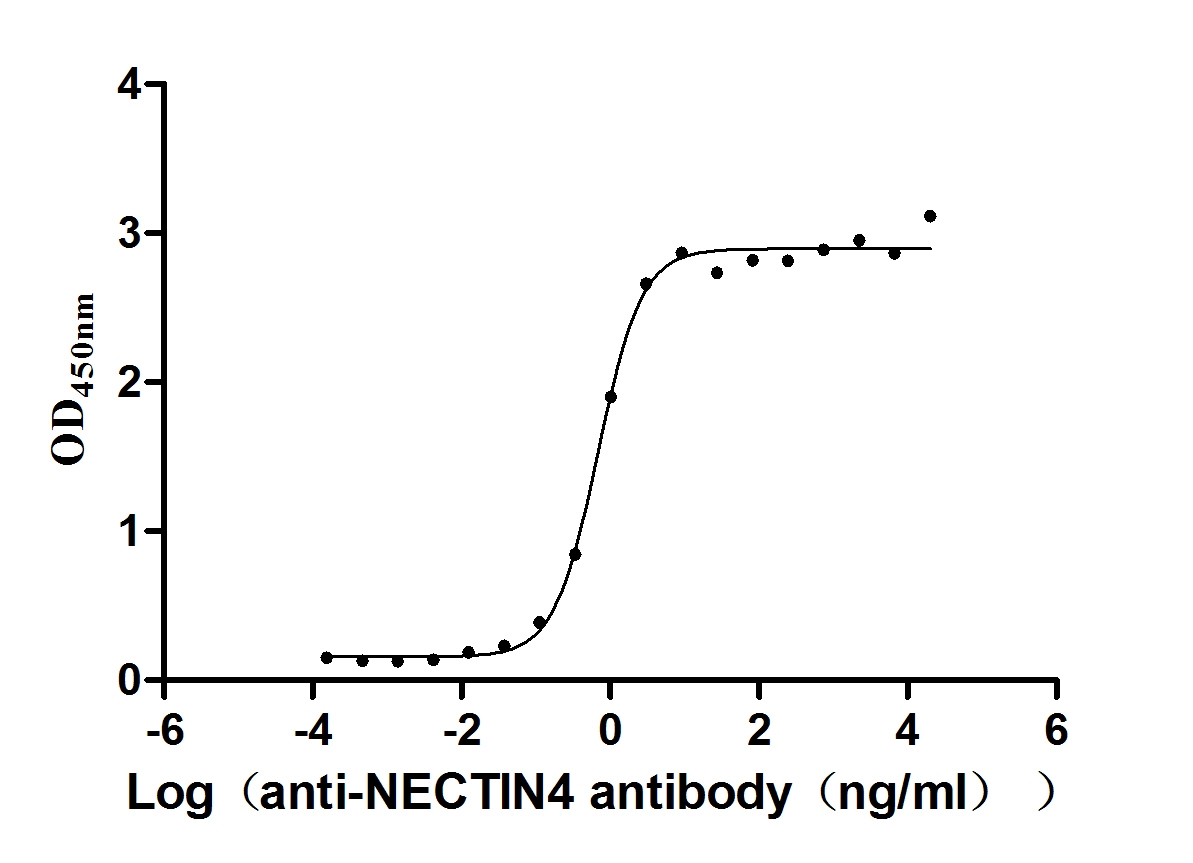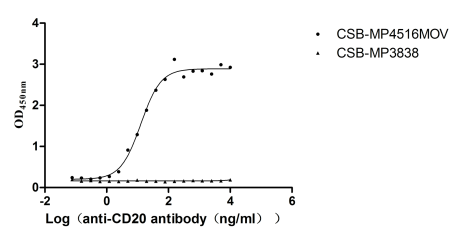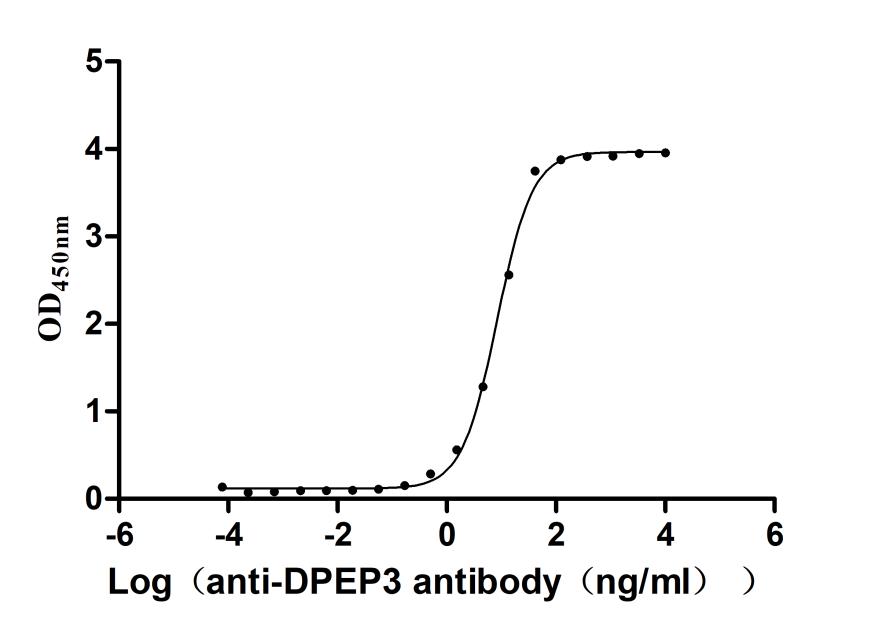Recombinant Mouse Chemokine-like receptor 1 (Cmklr1)
-
中文名稱:
-
貨號:CSB-CF005614MO
-
規(guī)格:¥9720
-
圖片:
-
其他:
產(chǎn)品詳情
-
純度:Greater than 85% as determined by SDS-PAGE.
-
基因名:Cmklr1
-
Uniprot No.:
-
種屬:Mus musculus (Mouse)
-
蛋白長度:Full Length
-
來源:in vitro E.coli expression system
-
分子量:43.3 kDa
-
表達(dá)區(qū)域:1-371aa
-
氨基酸序列MEYDAYNDSGIYDDEYSDGFGYFVDLEEASPWEAKVAPVFLVVIYSLVCFLGLLGNGLVIVIATFKMKKTVNTVWFVNLAVADFLFNIFLPMHITYAAMDYHWVFGKAMCKISNFLLSHNMYTSVFLLTVISFDRCISVLLPVWSQNHRSIRLAYMTCSAVWVLAFFLSSPSLVFRDTANIHGKITCFNNFSLAAPESSPHPAHSQVVSTGYSRHVAVTVTRFLCGFLIPVFIITACYLTIVFKLQRNRLAKNKKPFKIIITIIITFFLCWCPYHTLYLLELHHTAVPSSVFSLGLPLATAVAIANSCMNPILYVFMGHDFRKFKVALFSRLANALSEDTGPSSYPSHRSFTKMSSLNEKASVNEKETSTL
Note: The complete sequence including tag sequence, target protein sequence and linker sequence could be provided upon request. -
蛋白標(biāo)簽:N-terminal 10xHis-tagged
-
產(chǎn)品提供形式:Liquid or Lyophilized powder
Note: We will preferentially ship the format that we have in stock, however, if you have any special requirement for the format, please remark your requirement when placing the order, we will prepare according to your demand. -
緩沖液:If the delivery form is liquid, the default storage buffer is Tris/PBS-based buffer, 5%-50% glycerol. If the delivery form is lyophilized powder, the buffer before lyophilization is Tris/PBS-based buffer, 6% Trehalose.
-
復(fù)溶:We recommend that this vial be briefly centrifuged prior to opening to bring the contents to the bottom. Please reconstitute protein in deionized sterile water to a concentration of 0.1-1.0 mg/mL.We recommend to add 5-50% of glycerol (final concentration) and aliquot for long-term storage at -20℃/-80℃. Our default final concentration of glycerol is 50%. Customers could use it as reference.
-
儲存條件:Store at -20°C/-80°C upon receipt, aliquoting is necessary for mutiple use. Avoid repeated freeze-thaw cycles.
-
保質(zhì)期:The shelf life is related to many factors, storage state, buffer ingredients, storage temperature and the stability of the protein itself.
Generally, the shelf life of liquid form is 6 months at -20°C/-80°C. The shelf life of lyophilized form is 12 months at -20°C/-80°C. -
貨期:Delivery time may differ from different purchasing way or location, please kindly consult your local distributors for specific delivery time.
-
注意事項(xiàng):Repeated freezing and thawing is not recommended. Store working aliquots at 4°C for up to one week.
-
Datasheet & COA:Please contact us to get it.
相關(guān)產(chǎn)品
靶點(diǎn)詳情
-
功能:Receptor for the chemoattractant adipokine chemerin/RARRES2 and for the omega-3 fatty acid derived molecule resolvin E1. Interaction with RARRES2 initiates activation of G proteins G(i)/G(o) and beta-arrestin pathways inducing cellular responses via second messenger pathways such as intracellular calcium mobilization, phosphorylation of MAP kinases MAPK1/MAPK3 (ERK1/2), TYRO3, MAPK14/P38MAPK and PI3K leading to multifunctional effects, like, reduction of immune responses, enhancing of adipogenesis and angionesis. Resolvin E1 down-regulates cytokine production in macrophages by reducing the activation of MAPK1/3 (ERK1/2) and NF-kappa-B. Positively regulates adipogenesis and adipocyte metabolism.
-
基因功能參考文獻(xiàn):
- PI3K inhibition attenuates hepatic steatosis and KC-mediated inflammation via down-regulation of CMKLR1 and NLRP3 in HFD mice PMID: 28905319
- These findings support a fundamental biological function for chemerin/CMKLR1 to balance osteoblastogenic and adipogenic signaling and thereby contribute to the maintenance of pluripotency in mesenchymal stem cells. PMID: 27733019
- Chemerin-CMKLR1 activates Akt/mTOR and ERK pathways and facilitates preadipocyte proliferation, adipogenesis, and angiogenesis. Gax weakens the effect of chemerin on preadipocyte biofunctions. PMID: 28326537
- CMKLR1 exacerbated the proliferation and migration of VSMCs by activating ERK1/2. PMID: 27792688
- CMKLR1 gene deletion attenuates the effects of chronic DHT treatment on ovarian function in experimental PCOS, likely via BMP4 signaling. PMID: 26893072
- Loss of CMKLR1 exacerbates glucose intolerance and insulin resistance in mice fed high fat diets. PMID: 26972253
- The chemerin15 (C15) precursor, chemerin, and its receptor, ChemR23, are both upregulated after skin damage and the receptor is expressed by macrophages, neutrophils, and keratinocytes. C15 delivery dampens immediate inflammatory events. PMID: 24881877
- Results indicate that Abeta42 activates CMKLR1, leading to glia cell migration and clearance of Abeta42; and is involved in Abeta processing and clearance PMID: 25079809
- Increased chemerin expression in dermal blood vessels may be associated with the development of digital ulcers in systemic sclerosis. PMID: 25539827
- In brown adipose tissue, cold acclimation strongly diminished chemerin gene expression, whereas obesogenic diets augmented expression. PMID: 25224322
- Hematopoietic Deletion of Cmklr1 Does not Affect the Development of Insulin Resistance or nonalcoholic fatty liver disease. PMID: 24781986
- ChemR23 is expressed in neutrophil granules and rapidly upregulated upon neutrophil activation. PMID: 23999103
- Development of a membrane-anchored chemerin receptor agonist as a novel modulator of allergic airway inflammation and neuropathic pain. PMID: 24659779
- Data suggest that chemerin/ChemR23 signaling is not essential for adipocyte differentiation, but it appears to play a role in control of body weight and energy metabolism as overweight/obesity progresses. PMID: 24084834
- ChemR23 forms homomers, and provide data suggesting that ChemR23 also forms heteromers witChemR23 forms homomers, and provide data suggesting that ChemR23 also forms heteromers with the chemokine receptors CCR7 and CXCR4. PMID: 23469143
- Downstream targets of Chemerin/ChemR23 signaling are phosphorylated in vitro and are expressed in mouse tooth development, suggesting roles for Chemerin/ChemR23-mediated epithelial-mesenchymal cell signaling during tooth morphogenesis. PMID: 23053848
- These results rule out the direct anti-inflammatory effect of chemerin on macrophages ex vivo, described previously in the literature, despite the expression of a functional ChemR23 receptor in these cells. PMID: 22768214
- ChemR23-dependent recruitment of plasmacytoid dendritic cells contributes to adaptive immune responses and viral clearance, and also enhances the inflammatory response;the chemerin/ChemR23 system plays important roles in the physiopathology of viral pneumonia PMID: 22072972
- the results of this study reveal a novel involvement for CMKLR1 in myogenic differentiation in vitro and suggest an important role for CMKLR1 in proper muscle development in vivo. PMID: 22460713
- Collectively these data provide compelling evidence that CMKLR1 influences adipose tissue development, inflammation, and glucose homeostasis and may contribute to the metabolic derangement characteristic of obesity and obesity-related diseases. PMID: 22186410
- Data suggest may a potential role for chemerin and CMKLR1 in the regulation of inflammatory responses in the tumor microenvironment. PMID: 21752353
- Our data support a role for ChemR23 in directing innate and adaptive immune cells to cigarette smoke-exposed lungs PMID: 21430224
- data support a novel role for chemerin/CMKLR1 signaling in regulating adipogenesis and osteoblastogenesis of bone marrow-derived precursor cells PMID: 19929432
- During peritoneal inflammation, chemerin peptide 15 administration enhances microbial particle clearance and apoptotic neutrophil ingestion by macrophages in wild-type but not chemerin peptide 23 receptor-deficient mice. PMID: 20363975
- Results provide a necessary basis for further studies of the gene regulation and function of this chemoattractant-like receptor and will be useful when manipulating the gene in the development of transgenic animal models. PMID: 15019996
- Data have demonstrated a novel role for chemerin/CMKLR1 signaling as a positive regulator of adipocyte differentiation and metabolic function in the 3T3-L1 model of adipogenesis. PMID: 19446731
- the mouse chemerin/ChemR23 system is structurally and functionally conserved between human and mouse, and mouse can therefore be considered as a good model for studying immune responses in inflammatory diseases. PMID: 19841182
- CMKLR1 participates in the inflammatory mechanisms of experimental autoimmune encephalomyelitis and represents a potential therapeutic target in multiple sclerosis. PMID: 19864606
顯示更多
收起更多
-
亞細(xì)胞定位:Cell membrane; Multi-pass membrane protein.
-
蛋白家族:G-protein coupled receptor 1 family
-
組織特異性:Expressed in the differentiated adipocytes (at protein level). Ubiquitous. Highly expressed in adipose tissue and immature plasmacytoid dendritic cells (DCs) and at lower levels in myeloid DCs, macrophages, and NK cells. Expressed on macrophages isolated
-
數(shù)據(jù)庫鏈接:
Most popular with customers
-
Recombinant Human Nectin-4 (NECTIN4), partial (Active)
Express system: Mammalian cell
Species: Homo sapiens (Human)
-
Recombinant Macaca fascicularis Membrane spanning 4-domains A1 (MS4A1)-VLPs (Active)
Express system: Mammalian cell
Species: Macaca fascicularis (Crab-eating macaque) (Cynomolgus monkey)
-
Recombinant Human Oncostatin-M (OSM), partial (Active)
Express system: Mammalian cell
Species: Homo sapiens (Human)
-
Recombinant Macaca fascicularis Dipeptidase 3(DPEP3) (Active)
Express system: Mammalian cell
Species: Macaca fascicularis (Crab-eating macaque) (Cynomolgus monkey)

















